Location:
Webinar / International
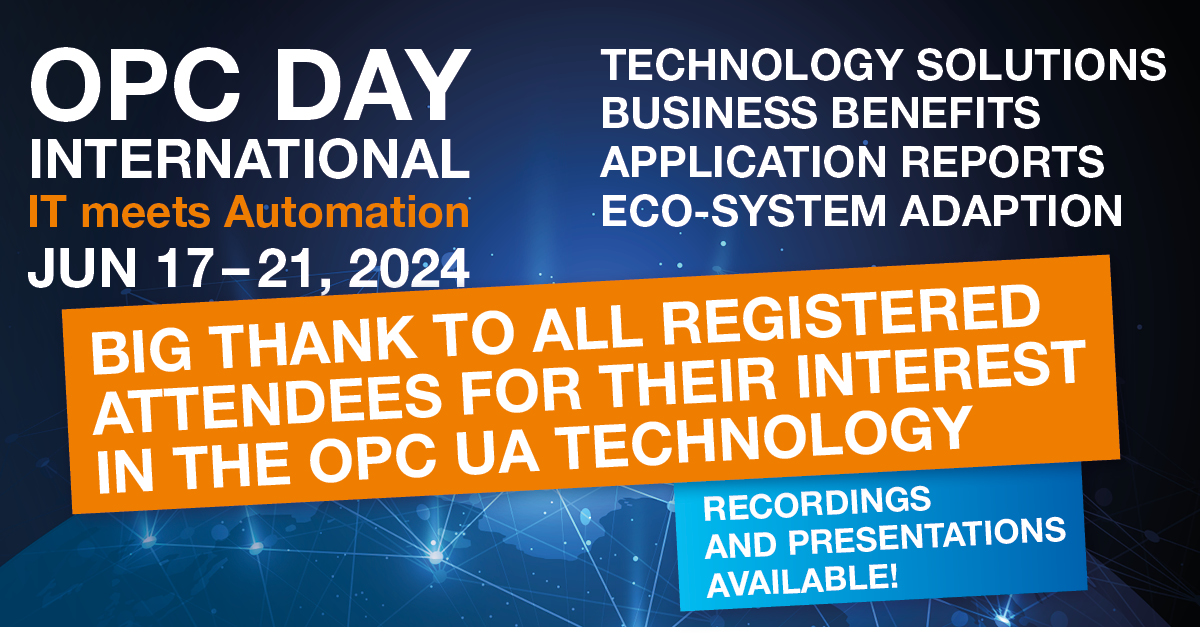
Welcome to the “OPC Day 2024 – International” – for the fifth time as a digital event.
The OPC Foundation will host the digital event from June 17-21, 2024 with 3 hours per day.
Each session will be held twice in different time zones to serve Americas, Europe and Asia.
- Europe/Asia slot: 08:00am – 11:00am CEST
- Americas / Europe slot: 09:00am – 12:00pm PDT | 6:00pm – 9:00pm CEST
Welcome to the “OPC Day 2024 – International” – for the fifth time as a digital event.
The OPC Foundation will host the digital event from June 17-21, 2024 with 3 hours per day.
Each session will be held twice in different time zones to serve Americas, Europe and Asia.
- Europe/Asia slot: 08:00am – 11:00am CEST
- Americas / Europe slot: 09:00am – 12:00pm PDT | 6:00pm – 9:00pm CEST
Agenda
- Details follow
Call for paper
- We invite submissions across 6 conference tracks
- Paper submission
The submission system opens on February 1st, 2024.
Deadline: May 1st, 2024, 23:59 CET (Central European Time)
Notification of (conditional) acceptance: May 22, 2024. - When submitting your paper, please consider the following:
- The language of the conference, and of all paper submissions, is English.
- All papers need to be submitted to one – and only one – of the 6 conference tracks.
- An author may be an author or co-author of a maximum of three (4) manuscripts. If an excessive number of papers are submitted, only the three first will be kept and the rest will be desk rejected.
- Submissions must be original. Plagiarism checks will be done prior to sending out submissions for review.
Registration
- Please register below – the detailed conference login will be shared later
Registration
EUROPE / ASIA
Please use this registration for the daily Europe / Asia slot
08:00 am – 11:00 am CEST
AMERICA / EUROPE
Please use this registration for the daily Americas / Europe slot
09:00 am – 12:00 pm PDT | 6:00 pm – 9:00 pm CEST
Agenda
Day 1 (June 17)
Keynote: Status & Update OPC Eco-System
OPC UA Cloud Initiative
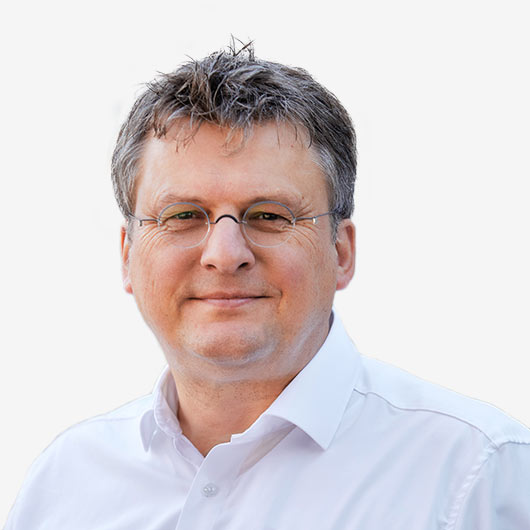
Stefan Hoppe,
President and Executive Director OPC Foundation
OPC UA for AI
The OPC Foundation initiated a new working group “OPC UA for AI”. This presentation gives an overview on the trends and goals like
- Use of AI technologies in the engineering phase
- Use of OPC UA specification and OT as data source for AI systems
- Use of AI-generated configuration files for industrial connectivity software leveraging OPC UA
- Use of AI-based interfaces for the operation of automation systems
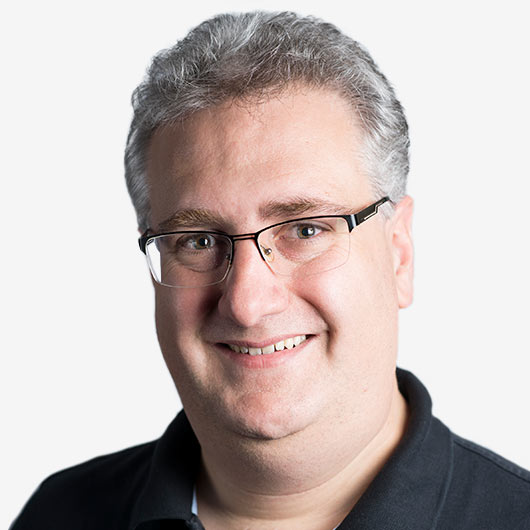
Dr. Holger Kenn,
Microsoft
OPC UA in vending industry
The European Vending & Coffee Service Association (EVA) is a not-for-profit trade association established in 1994, representing the interests of the whole European coffee service and vending industry vis-à-vis the European Union Institutions and other relevant authorities or bodies.
European Vending & Coffee Service Association and OPC Foundation started a Joint Working Group “OPC UA for Vending, Office Coffee Service & Automated Retail Working Group”.
This presentation is about to learn about the aim to develop an OPC UA Information Model for the communication between a vending machine, its peripherals, and the company’s information systems. A vending machine must be understood as a self-service machine that dispenses food (including drinks, such as coffee) and non-food products using different dispensing technologies.

Erwin Wetzel,
EVA
Together upwards: OPC UA in the TEXUS Research Rocket Program
OPC UA is the ideal solution for the data handling needs of our suborbital missions’ program. We use it during the development, test and operations phases of the scientific instruments that are flying on the TEXUS research rockets. In our presentation we provide an overview of the OPC UA application throughout the life cycle and an outlook to future enhancements.

Airbus Defence and Space

Enrico Noack,
Airbus Defence and Space
Tobacco Companion Spec in praxis by PMI
While Philip Morris International Inc. is widely known as a cigarette company, in 2016 it announced its new purpose: To deliver a smoke-free future by focusing its resources on developing, scientifically substantiating, and responsibly commercializing smoke-free products that are less harmful than smoking, with the aim of completely replacing cigarettes as soon as possible.
To achieve this transformation, PMI has been expanding manufacturing capacity and diversity. There, the need to make manufacturing equipment digitally operational with speed and efficiency has never been greater; allowing faster ramp up of production, scaling and optimizing new manufacturing processes in a data driven way. Starting in 2017, PMI has been building a “digital foundation” based on OPC UA and the TMC (Tobacco Machine Communication) companion specification to exchange information in a structured, standardized and secure way with their manufacturing equipment. From simple data collection to advanced AI solutions, the standard has been a catalyst for the digital transformation of PMI’s shop floor.

Josselin Vallee,
PMI
Day 2 (June 18)
Rapid development with OPC UA over MQTT
There are many applications that simply need to get a fixed set of data out of device and have limited need for information models. These applications requirements can be met quickly with OPC UA over MQTT. This talk will walk through the steps to create an application to publish data and metadata. It will also demonstrate how to send commands back to a device with actions.

OPC Foundation
OPC UA and UNS
UNS is an architecture that uses the MQTT topic tree to organize information provided by different participants. The talk will demonstrate how OPC UA over MQTT metadata and discovery features can be used publish to device data to an enterprise specific topic hierarchy. It will also show how OPC UA over MQTT allow subscribers to automatically discover publishers and the data they publish.

OPC Foundation
OPC REST and OpenAPI Definitions
The REST API for OPC UA is now defined with Swagger/OpenAPI schema. This allows OPC UA clients to be developed without UA-specific libraries. This talk will walk through the process of creating a simple client that Browse/Read/Write and Call. It talk about features added the encoding to simplify client development.

OPC Foundation
.NET User Group : Bringing the open source .NET Stack to the next level
The OPC UA .NET Standard Stack is an open-source project to provide a .Net library for building OPC UA server/client applications. The repository is under the OPC Foundation organization on GitHub. It is currently maintained by a user group under the umbrella of the OPC Foundation. This talk will briefly introduce the user group and process that is taken for maintaining the quality of the stack. We will also walk through the steps for general users to report issues or even make contributions to the project.

Microsoft
Certification - Status of OPC UA FX certification
Because OPC UA FX will be used in real-time & safety-critical applications, OPC Foundation’s Field Level Communication (FLC) Initiative has decided to require mandatory certification for OPC UA FX products (i.e. controllers and field devices). Based on the OPC UA FX controller profile – specified in OPC 10000-84 – the FLC Test Development WG has created test cases and test scripts for the OPC UA Compliance Test Tool (CTT) in order to ensure that OPC UA FX products are compliant and interoperable with other products in machines, skids, factories and plants. This presentation will explain the concept and status to test the functionality of an OPC UA FX product, including the information model, the handling of UAFX connections as well as the offline descriptor.

OPC Foundation
Integrating PubSub Security in OPC UA FX
Adapting OPC UA PubSub to work with dynamic connections has required adapting PubSub security. We take a look at adaptions required to ensure a secure PubSub connection including the addition of a Push Model for the Security Key Service in Part 14, OPC UA FX architecture choices to ensure interoperability and robustness, and the workflow of the Security Key Service to provide keys to the PubSub Connections.

Schneider Electric
OPC UA Redundancy for High Availability Applications
Some industrial applications require uninterrupted control of the process over a long period of time. Redundancy is a common method to avoid failures and fulfil this requirement. The presentation shows the possibilities OPC UA offers for this.

Andreas Macher,
Siemens
Day 3 (June 19)
Enterprise deployment of OPC UA in oil and gas brownfield assets using a data gateway and a domain specific information model
Aker BP has 7 offshore oil production sites, 6 brownfield and one green-field, using OPC UA and the same OPC UA information model that was made for Equinor’s Johan Sverdrup field, and was also open sourced by Equinor.
For the purpose of efficient workflow for normalization and enrichment of data from the various sites, an OPC UA gateway from TGS-Prediktor was chosen.
Aker BP calls this their Digital Foundation, which is an enabler from the strategic value perspective. A total of 1.2 million data variables is part of the solution. Among benefits are, enhanced data quality, robust change processes, information management within OT domain, standardized semantics across enterprise assets and reduced number of interfaces towards the cloud environment.

Aker BP
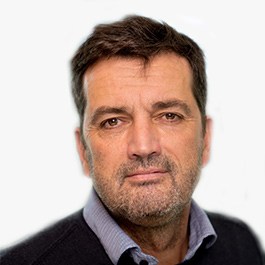
TGS
OPC UA for Wind Power Plants
A joint workoup was formed a little less than a year ago to map the IEC 61400-25 to OPC UA into a new companion specification for wind power plants. In this session we will learn about the progress of the work and also be informed about an updated version of IEC 61850 coming out of this activity.

TGS
OPC for Electrolyzer – integrate Electrolyzer in Hydrogen system with ease
Hydrogen Systems such as Energy Backup Solutions, Hydrogen Refueling Stations and Long-term Energy Storage becoming more popular and consist of many different components. Electrolyzer are a very important part of these systems and play a key role in the decarbonization of the Energy Grids. This session will show how easy it will be with OPC UA to integrate Electrolyzer with other components of a Hydrogen System and give an outlook what is to come for other Hydrogen components such as refueler and Fuel-Cells.

Base standard for Energy Consumption Management

Siemens
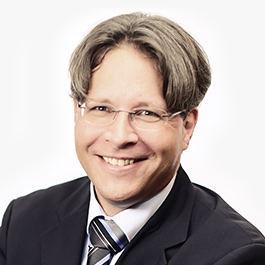
ascolab
Overview of activities and harmonization in the field of mechanical engineering
The mechanical and plant engineering industry is making great efforts to standardize machine data that is exchanged via interfaces. Over 60 OPC UA specifications have already been published in this area. At the heart of these standards is the OPC UA for Machinery specification. It forms the basis for all domain-specific specifications and can also be used without the use of other specifications.
In this presentation, the various activities and results of the numerous working groups will be presented. It will be shown for which machine types the standardization has already taken place or which areas are in the development process or are just starting. The presentation will focus on the OPC UA for Machinery standard, which serves as harmonization across the entire machinery and plant engineering sector. It consists of various published building blocks, each of which can be used to generate different added values.

VDMA e.V.
OPC UA FX Automation Component - Ongoing work and future outlook
The FLC Base Facet WG is responsible for defining the common interfaces, behaviors and state machines of OPC UA FX automation components (i.e., controllers and devices).
The functional model of an OPC UA FX Automation Component consists of one or more Functional Entities, input/output variables and configuration parameters.
Information between multiple Functional Entities is exchanged by OPC UA FX connections. These connections are based on OPC UA PubSub and are established by a so-called Connection Manager which is a mandatory service of an OPC UA FX controller.
In this presentation an update is given which specification enhancements are being elaborated for Controller-to-Controller connectivity. In addition, an outlook is given how the Functional Model of an Automation Concept will be extended to support the connectivity between controllers and field devices, including field instruments, remote I/Os and motion devices.

OPC Foundation
Day 4 (June 20)
Implementation of the NAMUR Open Architecture:
"One fits all" - one solution for all system architectures
The familiar concept of NAMUR Open Architecture opens up new possibilities for plant operators to optimize maintenance processes or increase productivity. Thanks to the standardized data model PA-DIM (Process Automation – Device Information Model) and OPC UA, the way up to higher-level asset management systems or other cloud applications has already been implemented. But how do we collect the data for existing infrastructure from the field level with as little impact as possible? The broad portfolio of different protocols, bus systems, manufacturers and field devices in existing plants in the process industry makes a „one fits all“ solution difficult to implement. However, different approaches can be used to map the information for all field devices in the systems. For example, for 4-20 mA devices, the HART protocol can be used to transmit and evaluate corresponding data in addition to the process values. Here, already installed signal splitters offer a quick and easy way to open a second channel. However, even without a signal splitter, a channel for monitoring and optimization can be implemented using the secondary master function of the HART protocol. It is estimated that 4-20 mA and HART cover between 60-80% of the field devices used. The remaining 20-40% is made up of Modbus, Profibus, WirelessHART and, in future, Ethernet-APL. NOA solutions are also required for these fieldbus systems and protocols. So do we need a special NOA device for every fieldbus system and protocol? Or are there possibilities for a flexible „one fits all“ solution?

Sebastian Böse,
Beckhoff Automation
Applying OPC UA Information Models and other advanced OPC UA features over Brownfield Installations
Describe the model of an aggregating OPC UA server that can apply OPC UA information models over brownfield devices that use only basic, non-standard data models.
Also describe how other advanced OPC UA functionality, such as Security, Events, Methods, History and PubSub communication can be used with existing brownfield installations.
Represent how the solution has been applied in actual industrial use cases.

Jouni Aro,
Prosys OPC Ltd

Prosys OPC Ltd

Prosys OPC Ltd
Harmonizing FDI Device-data using OPC UA and PA-DIM Information Model
This paper spins the idea of retrieving the Field Device Data from Lower Automations Stacks using their respective supported protocols (e.g. HART, FieldBus). It also advocates harmonizing the retrieved data with its full context and meta data at different Automation layers using OPC UA Framework and its rich Information Models.
It also explains how this data can be moved to Azure Cloud and recreate a Digit Twin of the devices in the Azure IOT Hub.

Utthunga Technologies Pvt. Ltd

Praveen Kumar Singh,
Vinay B R
A new digital tool for EU regulation - The Digital Product Passport under the new Ecodesign for Sustainable Product Regulation (ESPR)
The Ecodesign Regulation for Sustainable Products (ESPR) creates a horizontal product regulation for the European internal market.
It is intended to be the future main instrument for circular products in the European Union and therefore open the way to a circular economy.
The aim is to make sustainable products a standard. With the implementation of the Ecodesign Regulation, the scope of the original Ecodesign Directive has been greatly expanded.
Whereas previously only energy-related products were considered, it will also be possible to regulate many other product groups under the new Ecodesign Regulation.
When the regulation comes into force, information and reporting requirements will become mandatory.
In the context of digitalization, the digital product passport is now to be implemented as a tool for these reporting requirements.
The digital product passport is a collection of structured data with a predefined scope and defined property and access rights, which are transmitted via a unique identifier.
The content of this structured product data includes the components, materials and chemical substances used, as well as information on reparability, replaceability and professional disposal.
The data should originate from all phases of the product life cycle and should also be able to be used for various purposes in all these phases.
What does this mean for companies that fall under the corresponding product regulation?
What tasks will they have to fulfill?

VDMA
Introduction to the EU Battery Passport
The presentation provides a general picture of the EU Battery Regulation with an emphasis on the scope and requirement of a corresponding Battery Passport. It addresses the research focus of Fraunhofer FFB within this context and underscores the substantial challenges the EU Battery Regulation poses to the manufacturing industry, particularly from a technical point of view.

Fraunhofer Research Institution for Battery Cell Production FFB
AAS / DPP / PCF / DBP powered by OPC UA
OPC UA is a critical component to fulfill the requirements of the new EU legislation for the Digital Product Passport (DPP) as well as the Digital Battery Passport (DBP). With its vast ecosystem of modelling tools, best-in-class modelling capabilities and, in addition, the new REST interface that was recently added, OPC UA has all the ingredients to build DPPs and DBPs with ease. Product Carbon Footprint (PCF) data can be simply integrated from the shop floor and the supply chain. If you want to see how this works in practice, join the session!

Microsoft
Day 5 (June 21)
Device and Update Management based on OPC UA Part 100: Devices
In the presentation, first the motivation for a holistic device and update management system is highlighted: High IT security requirements make it necessary for device firmware and certificates to be monitored and, if necessary, updated at a central location. Then, the basics of the software update model as an add-in of OPC UA Part 100: Devices are discussed. After that it will be shown how the software update model has been integrated into address spaces of Phoenic Contact PLCs and what the underlying process for distributing and executing software updates looks like. An application for holistic device and update management is then presented, with which the following features are realized:
– Updating device firmware
– Updating PLC projects
– Centralized creation, management and distribution of certificates
– Global discovery server
The integration of device and update management into the existing IT security infrastructure will also be discussed. The presentation concludes with an outlook that shows the future potentials of device and update management.

Phoenix Contact Electronics GmbH
Using Companion Specification for Type based Client Application
In our talk, we will highlight the advantages of Companion Specifications, particularly from the view point of client developers. Companion Specifications are instrumental in defining domain-specific DataTypes, VariableTypes, and ObjectTypes, which can be used for the development of generic templates. We will demonstrate this concept’s effectiveness through the umati Dashboard, which utilizes such templates to integrate a diverse array of machines seamlessly.
Our methodology includes interpreting a Companion Specification’s model and adeptly mapping its nodes to visualization. The presentation will provide an exploration of the technical underpinnings, complemented by a demonstration of the template generation process and the straightforward integration of machines into the dashboard.

FVA GmbH

VDMA e.V.
A Query Language for OPC UA Event Filters
OPC UA Events are powerful but still underused in practice. This also stems from the effort of defining EventFilters.
Besides the selection of transmitted event fields, EventFilters also allow the definition of logical rules for server-side filtering of relevant events.This contribution proposes a query language to make OPC UA EventFilters more accessible. Examples are shown for a parser implementation as part of the open62541 library.

Florian Düwel,
Fraunhofer IOSB

Fraunhofer IOSB

Fraunhofer IOSB
OPC UA FX: Facet Approach for the Field interoperability including TSN and 5G
The Field Level Communications (FLC) initiative of the OPC Foundation is extending OPC UA to the field for the various use-cases in factory and process automation, and beyond. This will advance the OPC Foundation providing vendor independent end-to-end interoperability into field level devices. This presentation addresses the chosen technical approach for OPC UA Field eXchange (FX) to facilitate deterministic and converged industrial networks based on international standards out of IEC, IEEE, IETF, and 3GPP. In particular, the key interoperability concepts of the solution are explained, such as the use of network services and protocols for end stations and bridges.

Huawei Research Center Munich, Applied Network Technology Lab.
UAFX C2C Functionality for Robot Control Application
This paper delves into the use of OPC UA Pub/Sub over TSN in motion control applications, exploring its potential to factory floor to cloud communication capabilities. OPC UA, including C2C functionality via UAFX is employed as a real-time communication protocol, facilitating the exchange of data between controllers. Furthermore, OPC UA MQTT from the same stack is used to transmit data to the cloud for dashboarding purposes. This use case is implemented in a fully functional 6-Axis robot which is used in the packaging industry and supporting benchmarking measurements shows that the proposed design of OPC UA along with TSN is better performing compared to the legacy field-bus protocols. Also, the motion control application is always deterministic even after the convergence of IT and OT network
Key performance metrics, including round-trip time, network jitter, memory footprint, and system-level synchronization, are measured which supports that OPC UA Pub/Sub would be a right choice for filed level communication. Lessons learned from this solution development which include the importance of achieving faster cycle time communication in motion control applications through Pub/Sub over raw Ethernet frames, the ease of pushing motor control service data to the cloud and performing edge AIoT analytics is discussed in this paper.

BE.services GmbH

Pester
OPC UA Information Model Management and Unified Name Spaces
The paper investigates how Industrial IoT solution architectures can be designed to create Unified Name Spaces with the help of OPC UA Information models. The paper is based on two customer projects. (cloud-based IoT solutions across 100+ production sites; one customer process industry, another customer food & beverage, both projects still in PoC phase). To enable efficient IoT application development, the customers need to work with a central data repository as „single source of truth“. The paper proposes a solution architecture with central governance for OPC UA information models to be deployed on edge level, thus creating standardized OT-interfaces publishing machine data into a Unified Name Space.

Softing Industrial Automation GmbH
OPC Foundation in the world
This session is about OPC Foundation in the regions of the world: Our local colleagues from North America, China, Japan, Korea, Singapore and France will give short reports.
This Conference is taking place on Thursday April 20th, 11:00 -13:00
CET adressing OPC UA with Metaverse, Dataspaces and Asset Administration shell.
Join our conference at the Convention Center –
Room 3B
- live demonstrator OPC UA and the Metaverse
- live demo “OPC UA over MQTT” connecting lot of controllers via OPC UA over MQTT directly to cloud dashboards
- OPC UA via REST: get information about new working group adressing
The IT world desires to utilize the data from the OT space to be combined with additional concepts like Asset Administration Shell, Data Spaces, Digital Twins and Metaverse: All these initiatives and solutions are about sharing information between multiple companies with different use cases like product lifecycle data (AAS) or governance data (DataSpaces) etc. In most cases, they exchange the data via proprietary or standardized HTTP REST-Interfaces. - OPC UA for field: live demo of horizontal Controller-to-Controller communications based on OPC UA FX series – the one and only harmonized OPC UA solution for both Process- and Factory-Automation, including deterministic, motion, instrumentation, OPC UA Safety and OPC UA over 5G.
- live demo “GDS – Global Discovery Service” for secured exchange of certificates
These companies and partners will show solutions on the OPC Foundation booth in 2023:
- Brightly Works Oy
- Fraunhofer IOSB
- Hilscher
- logiccloud AG
- Matrikon
- Prosys OPC
- PTC/ Kepware
- Siemens
- Unified Automation
In addition we welcome our partners
- AutomationML
- FDT Group
- Spectaris with the LADS Companion Spec
